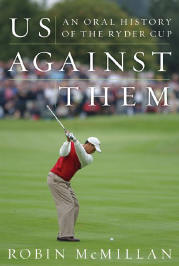Us Against Them: An Oral History of The Ryder Cup
Several years ago I used to play a text-based computer game called Mutual Assured Destruction.
Set during the Cold War, which was still going on at the time, the player determined when, where, and how many intercontinental missiles would be sent to a wide list of targets, before all of the cities in the player’s countries were wiped out by the computer’s decisions for the other side.
The eventual winning strategy did not rely upon incrementalism, the “message-sending” tactic used during the slow build-up of the Vietnam War.
Instead, the fastest victories were accomplished by overwhelming the opposition with a flood of missiles to each target. The computer’s defenses couldn’t handle all of the multiple incoming bombs, and the other side was quickly eliminated before it could send a similar response against the player’s cities.
I was reminded of this game as I read the fascinating reconstructions of strategy used by Ryder Cup captains during dozens of matches held since 1927.
In both cases there is extensive use of game theory, perhaps without realizing it. Nonetheless, learning what went into the decision to pair up teams or decide the playing order for the last day’s singles event made for a great read.
Robin McMillan went through the archives and tracked down many of the participants for their own take on their experience. Once again I’m struck by how golfers can remember yardage, club selection, and results from rounds that took place decades ago. Perhaps there really is something to the professional golfer’s power of concentration.
On the other hand, the pros’ memory-making tends to be reinforced by the requirement to answer media inquiries at the time of the event, so perhaps I shouldn’t be that impressed–but I am nonetheless.
McMillan does a nice job rehashing the story, familiar to avid golfers, of how the Cup came to be, how the eventual lopsided nature of the contests slowly diminished fan and player interest in the competition, and how Jack Nicklaus and others found a way to revive the event to the high-stakes, extremely popular fall contest it is today.
The appendix at the back of the book lists all of the results from each match, for the agate-type readers among us.
McMillan also recounts some of the tales of gamesmanship that some of the players sometimes used to great effect. Seve Ballesteros was a great match player, for example, not only because of his scrambling ability, but also because he was able to make his competition think more about him than their own game.
On the other hand, Paul Azinger and other American golfers were able to unnerve their opponents, and not just with their swing technique.
Everyone with experience in match play knows not to assume they have a hole won when their opponent is in trouble, but getting ahead of oneself emotionally remains one of the hardest tendencies to fight against during a match.
The professionals are just as prone to it as any of us duffers, as several of these interviews show.
Unlike normal golf, Ryder Cup competition also forces its participants to remember that they are in a team-based game, where the mindset is very different than the lone-wolf attitude they rely upon during their regular professional career. That, of course, is one of the major appeals of the Cup, both to the players and the fans.
The players who responded to McMillan’s interview requests frequently discuss this facet of the story, and its one of the common threads that bound all of the participants.
The really intriguing part of the story is how the captains approached their primary task of figuring out who should play with whom during the foursomes and four-ball matches, and the order of play during the last day’s singles event. Some captains were up to the task, and equally clearly, some were not.
Based on what these interviews divulged, the winning strategies are actually pretty simple. In foursomes, the alternate shot format, make sure each team has one player that can keep the ball in play, and another player capable of streaks of erratic brilliance.
In four-balls, try to match up players with similar temperaments and ball-striking abilities.
For the singles matches, however, the best strategy seems to take a page from Mutual Assured Destruction. Always lead off with your strongest players, and overwhelm the other side before the final match of the day.
More often than not, this method works, regardless of which side employs it. Both Europe and the United States have certainly won without using this tactic, but they’ve also unwittingly increased their odds of losing when they didn’t.
Sometimes, they’ve been forced to watch in stunned disbelief as their side lost, when they didn’t lead with their best guys first.
The book’s publication was timed to coincide with this year’s contest.
Unfortunately for the Americans, the Europeans whacked them again. However, I can’t help but think that if this year’s team had read this book before the event and “listened” to the players who preceded them, the outcome might have been different.
At least they’ll have McMillan’s collection of advice handy for the next time.
Review Date: November 13, 2004


